


 |
 |
 |
|||
|
|
|||||
| Building A Fleming That's Right For You - Part 3 | ||||
|
By Ron Ferguson After seeing our new Fleming 55 (55-203) loaded aboard the container ship in Kaohsiung in late February (2009), it was a seemingly long, anxious wait for the delivery day to arrive. Saturday, May 15, 2010 For the first several days after returning home from our second Kaohsiung trip I tried to locate the Ever Ulysses on the AIS vessel tracking web site, but following her on the journey across the Pacific was futile. From Kaohsiung, the published schedule included brief stops in Yantian and Hong Kong on the Chinese mainland, then northward to Osaka and Tokyo before heading across the Pacific. Unfortunately, as near as I could tell none of these ports participate in the AIS vessel tracking website. The yard we had selected for commissioning of 55-203 - she didn't have a name yet, so we knew her only as 55-203 - was Lake Union Yacht Center (LUYC), located about midway on the Ship Canal that connects Lake Union, through the Hiram M. Chittenden Locks (known locally as simply the Ballard Locks), to Puget Sound. We met several times with the LUYC owner and our project manager to finalize the commissioning work and the after-market systems we'd planned. With delivery of 55-203 delayed by a month, a big concern was to keep this year's work to a minimum so that we could stay with our scheduled departure date of May 1 for the summer's cruise to SE Alaska. Everyone assured us this schedule was still do-able, but deep down I figured the middle of May was more likely. On Monday, March 9, we received good news that the Ever Ulysses was due into Tacoma right on schedule - very early on the morning of the 13th. Wouldn’t you know it - our ship would come in on Friday, the 13th! Let’s hope this isn’t an omen. To our amazement, we also learned from the Chuck Hovey folks that Kathryn and I were on the list of authorized persons allowed into the Port of Tacoma container docks for the unloading. With the level of TSA security at America's port facilities since 9/11, we weren't at all sure this would be possible - but someone must have known how to talk successfully with the Port people. The night before scheduled arrival, I periodically checked the AIS website, and sure enough, at 9:00PM I "watched" the Ever Ulysses cruise into the entrance of the Strait of Juan de Fuca. During the night, she would then pass into Puget Sound and head southward for Tacoma. At 4:00AM I just happened to be awake, and went to my office to see her passing Seattle. A few minutes later, the track showed her in Tacoma’s Commencement Bay, ready for her moorage at the Port of Tacoma. 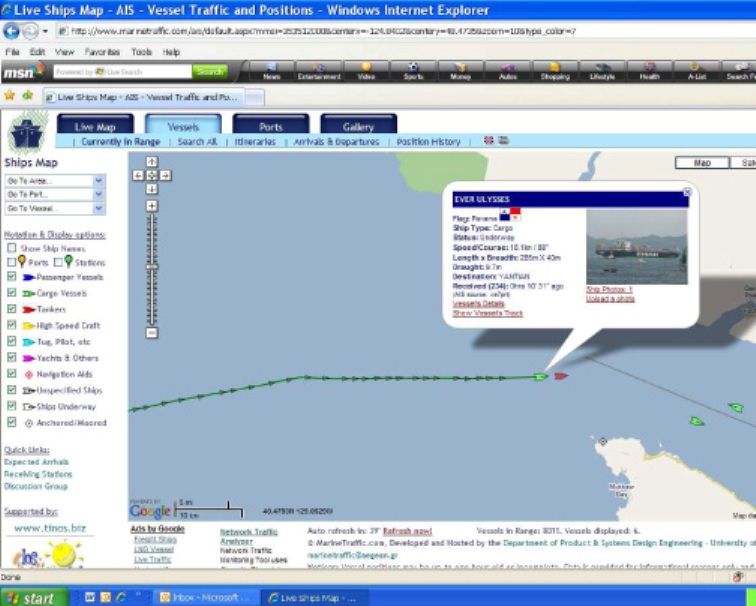 A chance visit to the AIS vessel tracking website shows the Ever Ulysses entering the Strait of Juan de Fuca at 9:00PM on Thursday evening. The Strait of Juan de Fuca separates the northern tip of Washington State’s Olympic Peninsula (bottom right of screen capture) from Canada’s Vancouver Island (upper right). The Strait leads into Puget Sound and southward to Seattle and Tacoma. (Click on any image to enlarge.)
A chance visit to the AIS vessel tracking website shows the Ever Ulysses entering the Strait of Juan de Fuca at 9:00PM on Thursday evening. The Strait of Juan de Fuca separates the northern tip of Washington State’s Olympic Peninsula (bottom right of screen capture) from Canada’s Vancouver Island (upper right). The Strait leads into Puget Sound and southward to Seattle and Tacoma. (Click on any image to enlarge.)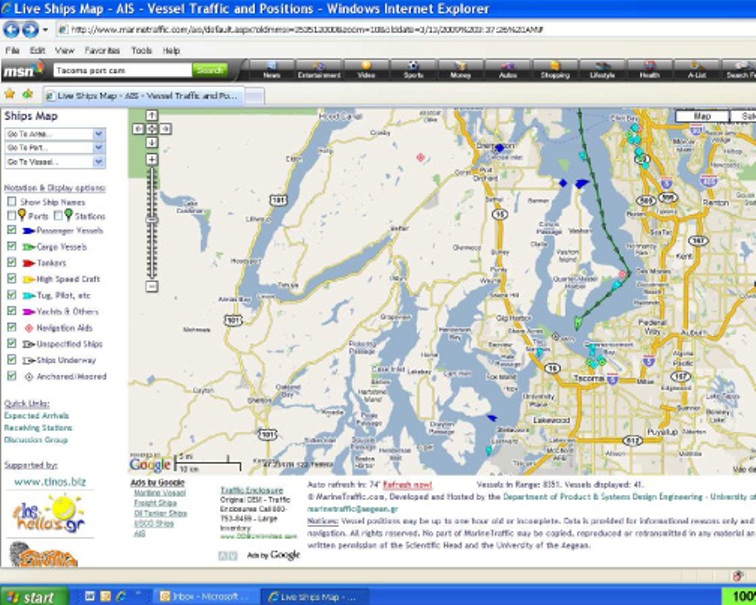 Throughout the night, I checked the AIS website to see the progress of the Ever Ulysses on its southward journey through Puget Sound. By 4:00AM, it had arrived at Tacoma’s Commencement Bay and was turning around to back into moorage position at the Port of Tacoma container docks.
Throughout the night, I checked the AIS website to see the progress of the Ever Ulysses on its southward journey through Puget Sound. By 4:00AM, it had arrived at Tacoma’s Commencement Bay and was turning around to back into moorage position at the Port of Tacoma container docks.At 6:15AM, Kathryn and I met up with the crew from Chuck Hovey Yachts and LUYC for the drive to Tacoma. Brian Hovey was on hand to oversee the unloading, and Mike Radding, Service Manager for Chuck Hovey Yachts, was with us to bring the electrical and engine systems to life aboard 55-203. Peter Schaefer, our sales broker at Chuck Hovey Yachts Seattle - was along to assist. John Alder, Yard Manager for LUYC, was our designated Skipper for the short cruise from Tacoma to Seattle. As expected, security at the Port of Tacoma container docks was heavy, and after careful ID checks at the security gate we were escorted to a worker's lunch room and break shack on the opposite side of the pier from the Ever Ulysses. It was eerie to see her 6,200 miles from our visit in Kaohsiung barely three weeks earlier - and a real testament to the speed of today's freighters. For about an hour we sat around the break shack twiddling our thumbs, as there wasn't any activity at all around the Ever Ulysses. Shortly after 8AM, we could see movement around the four huge overhead cranes that were positioned to begin unloading the Ever Ulysses. Before long, they were offloading containers at a surprisingly fast pace, and it was fascinating to watch. A swarm of “straddle” cranes continuously buzzed by, some carrying containers to be loaded, while others hauled away off-loaded containers. It looked like the scene from Star Wars where the gigantic robotic leviathans clashed. Warning horns from every piece of equipment produced a cacophony of sounds. I could see that Kathryn - who absolutely loves to drive heavy equipment - was just itching to operate one of these cranes! We could see that one overhead crane was working exclusively on the narrow stack of containers above the spot where we knew 55-203 was stowed, way below decks. With over 100 containers to offload above her, we had no idea how long it would take to uncover 55-203. 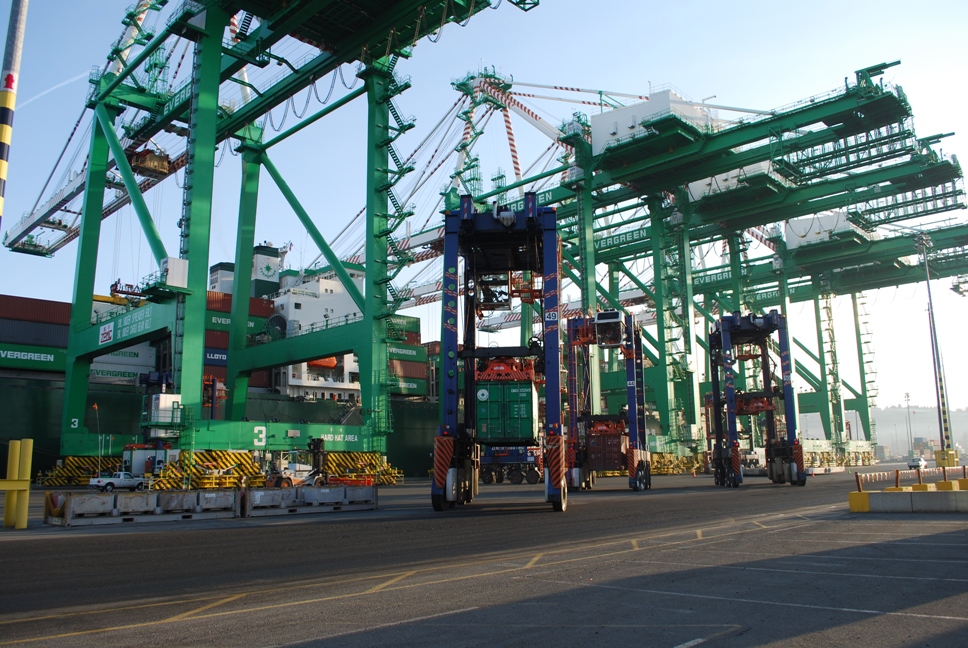 By 8:30AM, serious activity began with four overhead cranes positioned to offload containers, as fast as a fleet of "straddler" - for lack of a better name - buzzed around hauling containers away to staging areas.
By 8:30AM, serious activity began with four overhead cranes positioned to offload containers, as fast as a fleet of "straddler" - for lack of a better name - buzzed around hauling containers away to staging areas.At 9:00AM, a minibus pulled up outside the break shack, and we were escorted to the bus. It carried us about 100' across the pier to the Ever Ulysses gangway - another reminder of the level of security here in the U.S., versus the docks at Kaohsiung, where we roamed unattended without anyone batting an eye. We didn't wait for orders - or anyone to further escort us - and we scrambled up the gangway as quickly as we dared. As we emerged on deck, though, someone noticed that a couple of us didn't have hardhats, so we were stopped and had to wait for some loaners to be sent up. This gave us a chance to take in the magnificent view looking over the container facility with all the activity going on below us. Once we satisfied the safety issues, we didn’t waste time and quickly descended 50’ down a very steep stairway through the deck floor and headed aft towards the area where we knew 55-203 was located. 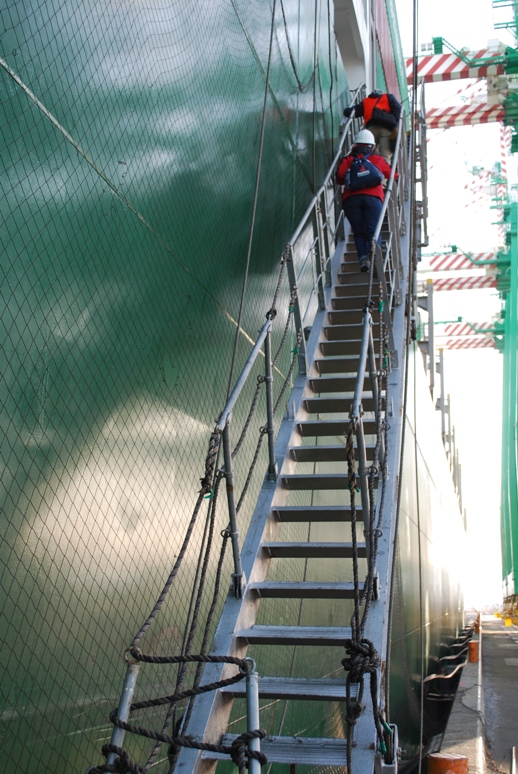 We didn't have to be asked twice if we wanted to board - before anyone could stop us, we scampered up the gangway, rickety as it was.
We didn't have to be asked twice if we wanted to board - before anyone could stop us, we scampered up the gangway, rickety as it was.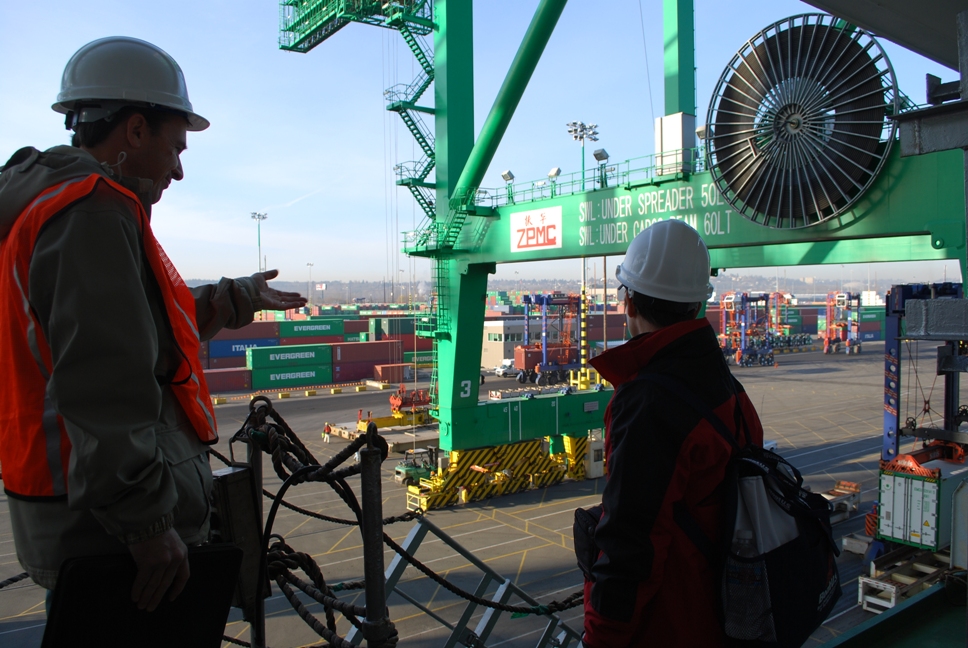 At the top of the gangway we were forced to stop, as someone in an official capacity noticed that some of us didn't have hardhats. While we waited for them to be brought up to us, looking out over the pier below it was hard to grasp the enormity of this operation. We're close to a hundred feet above the pier, and the overhead crane dwarfs us. The large spool at the upper right reels in/out the 6" thick electrical conduit that powers the crane.
At the top of the gangway we were forced to stop, as someone in an official capacity noticed that some of us didn't have hardhats. While we waited for them to be brought up to us, looking out over the pier below it was hard to grasp the enormity of this operation. We're close to a hundred feet above the pier, and the overhead crane dwarfs us. The large spool at the upper right reels in/out the 6" thick electrical conduit that powers the crane.Maneuvering below decks, along dark and narrow passageways of a 964’ container ship is disorienting. Tracing our way to 55-203 was tricky, and it was important not to lose sight of the person in front, particularly since we were on the starboard side of the freighter this time, whereas it was the port side in Kaohsiung (we found that below deck companionways are not symmetrical). With the security we'd already been through, we were surprised it was left up to us to find our way, unescorted. Finally, after several 90° turns to left and right, we saw rays of sunlight streaming down from above, and then spotted 55-203. She was exactly as we’d left her two weeks earlier, looking no worse for wear, and surprisingly clean (since she had the luxury of essentially riding below decks. Four longshoremen (surprisingly, one was a women, so are they called "longshorepeople" to be PC?) were removing the cradle straps and discussing where to position the lift slings. As they worked away on their task, we began to remove the protective tape along the lower hull, as it would quickly come off in the salt water of Puget Sound once we were underway. The Chuck Hovey and LUYC crews were busy in the engine room and pilot house getting 55-203's electrical system and engines ready to fire up the moment she was set in the water. The whole process took barely 45 minutes. 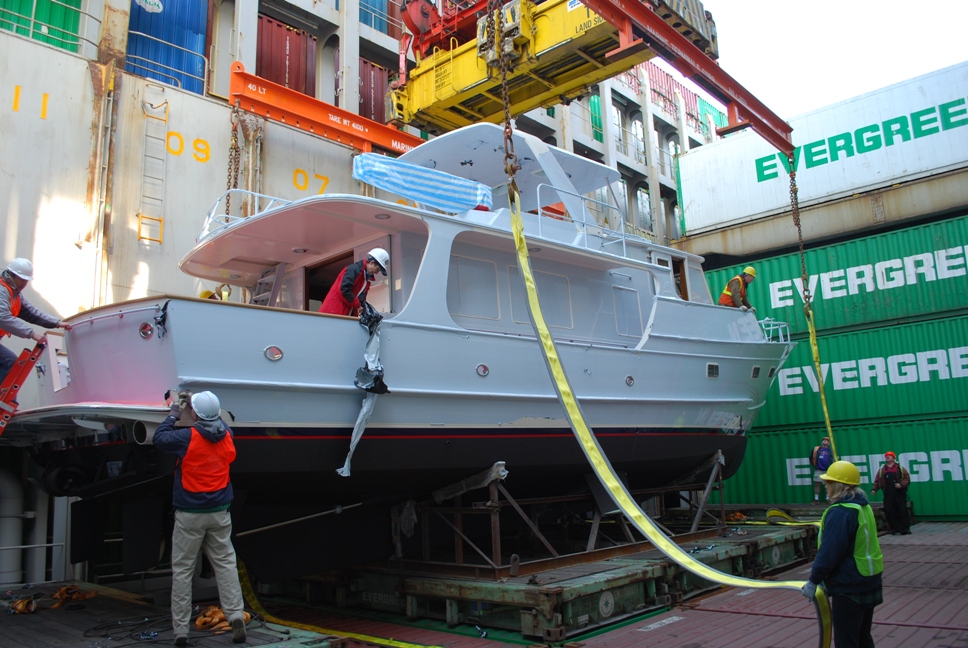 55-203 looked just like we’d left her in Kaohsiung. Within minutes, straps for slinging her out were being put into place, as the Chuck Hovey and LUYC crew checked out all systems for starting the engines. Removing the protective tape was the task that the rest of us worked on.
55-203 looked just like we’d left her in Kaohsiung. Within minutes, straps for slinging her out were being put into place, as the Chuck Hovey and LUYC crew checked out all systems for starting the engines. Removing the protective tape was the task that the rest of us worked on.With preparations complete, we watched as 55-203 was slowly - very slowly - lifted from the cradle she rode in across the Pacific, After snapping one or two last photographs, we quickly retraced our steps - luckily someone remembered exactly how we'd gotten there. At the top of the gangway, we watched as 55-203 moved laterally above our heads, away from the freighter and out above the pier. We hurriedly made our way down the gangway - still rickety as ever, and the fear going down is worse than going up. 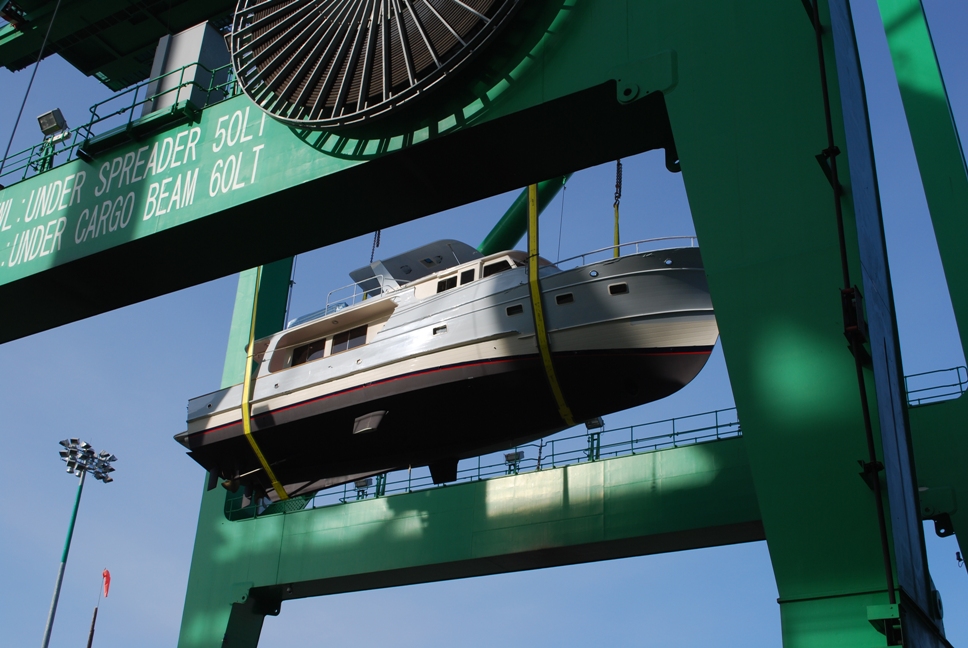 Barely an hour had elapsed before 55-203 was brought out and lowered by the Port crane. Note the protective blue tape on the side of the hull.
Barely an hour had elapsed before 55-203 was brought out and lowered by the Port crane. Note the protective blue tape on the side of the hull. 55-203 begins a slow movement towards the stern of the Ever Ulysses. The crane operator doesn’t want her to start rocking back and forth in the sling, so the movement is just a few feet a minute.
55-203 begins a slow movement towards the stern of the Ever Ulysses. The crane operator doesn’t want her to start rocking back and forth in the sling, so the movement is just a few feet a minute.As the overhead crane lowered 55-203 to a few feet above the pier, we followed along on foot. It seemed to take forever, but finally at the stern of the Ever Ulysses, she was slowly maneuvered over the water and lowered so the swim step was just level with the pier. We quickly stepped aboard, and she was then lowered for her first-ever taste of salt water. 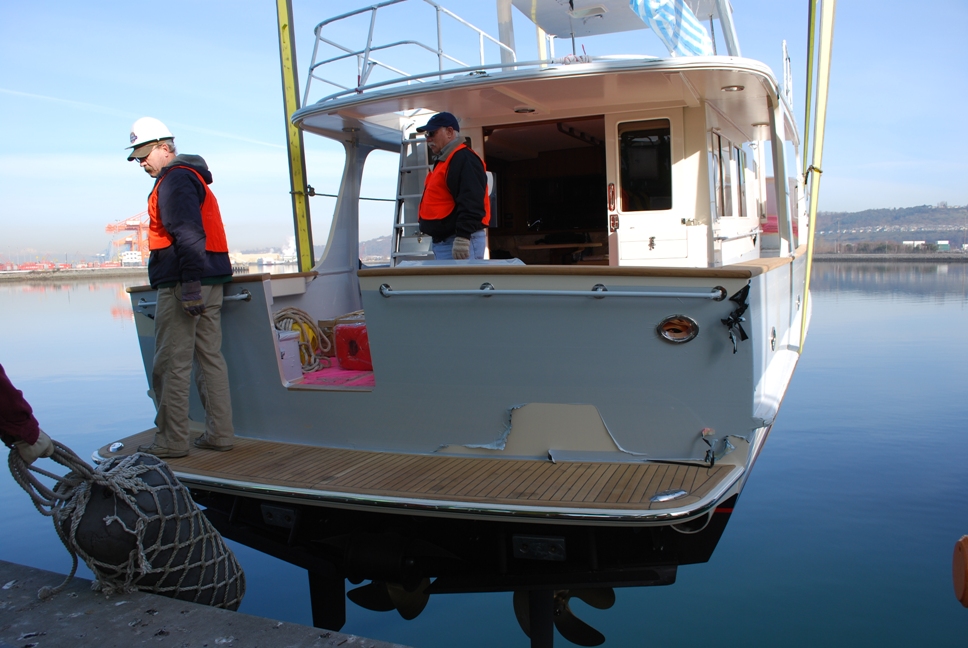 When the swim step is at pier level (but the keel still 15' above the water), a large fender is inserted at the pier to keep the swim step from damage, and we all step across a 3’ chasm to board 55-203. John Alder is on the swim step; Mike Radding is in the cockpit.
When the swim step is at pier level (but the keel still 15' above the water), a large fender is inserted at the pier to keep the swim step from damage, and we all step across a 3’ chasm to board 55-203. John Alder is on the swim step; Mike Radding is in the cockpit.With the stern of the Ever Ulysses towering 10 stories above us, 55-203’s engines were started, the slings were unfastened and we were on our way. It was 10:22AM – the unloading had taken a mere hour and 22 minutes. 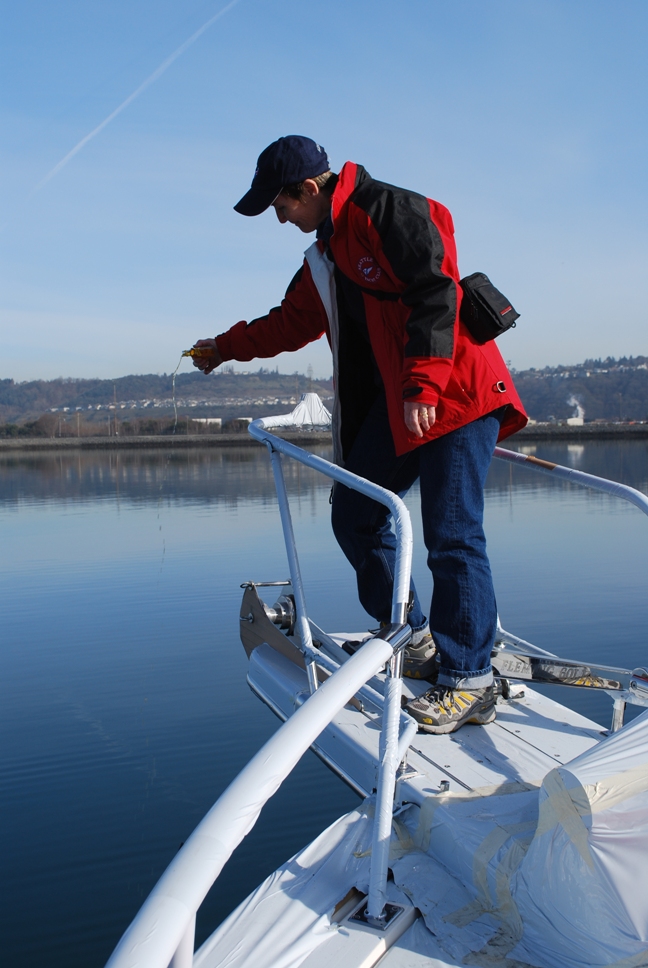 From the bow, an offering of fine rum is made to King Neptune in the hopes that we'll have fair cruising on 55-203.
From the bow, an offering of fine rum is made to King Neptune in the hopes that we'll have fair cruising on 55-203.As we slowly motored north through Commencement Bay, the commissioning crew was checking systems. Kathryn and I quietly moved to the bow to make our ceremonial rum offering to King Neptune. 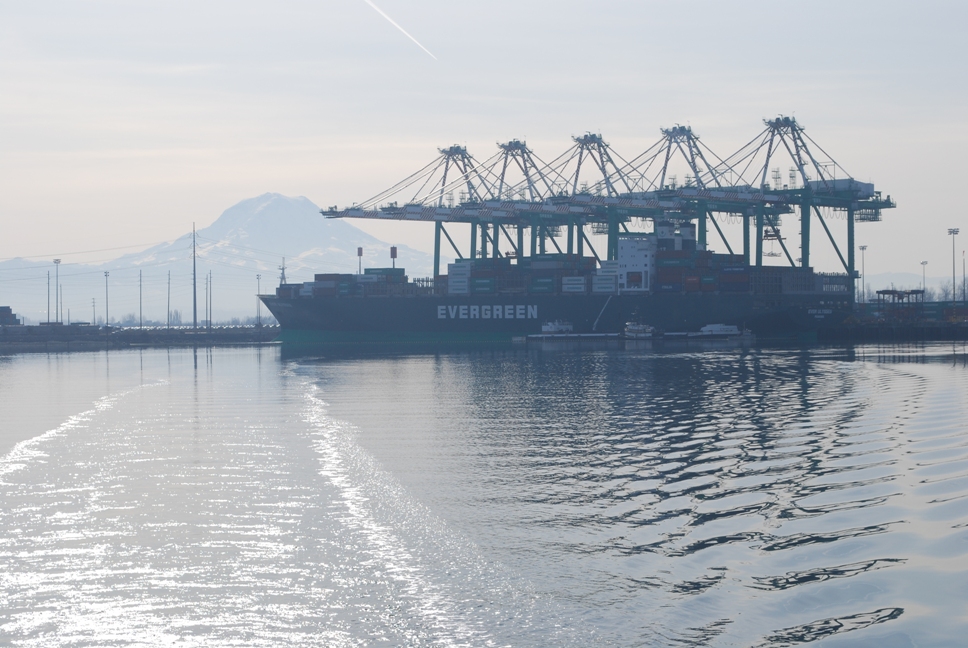 Astern as we pulled away from the Ever Ulysses, the majestic 14,411’ Mt. Rainier was visible - we thought of a Pacific Northwest truism - any day that you can see Mt Rainier is a good day - and that was certainly true today.
Astern as we pulled away from the Ever Ulysses, the majestic 14,411’ Mt. Rainier was visible - we thought of a Pacific Northwest truism - any day that you can see Mt Rainier is a good day - and that was certainly true today.During the hour long cruise north to Seattle, we began to feel that 55-203 was our new yacht – still unnamed at this moment - and not legally signed over to us just yet. Once inside the Ballard Locks that separate Puget Sound from Lake Union, Fleming 55-203 was at her new home for the next four months of commissioning and outfitting - almost ready to become Flying Colours. We didn’t make it to SE Alaska as planned, but we nevertheless enjoyed two wonderful months of Summer 2009 cruising the Inside Passage of British Columbia. 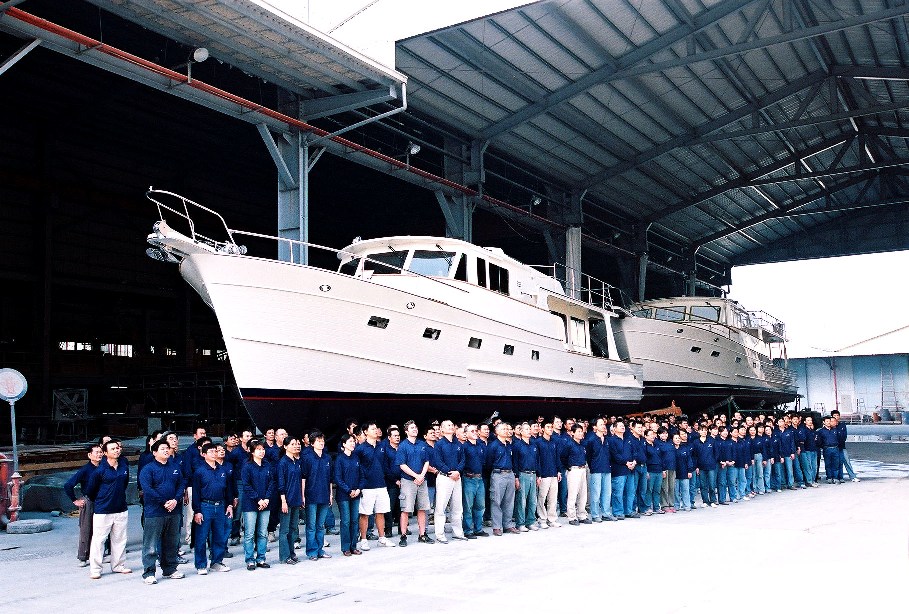 A few days later, a CD from Adi arrived in the mail, containing several hundred photos of 55-203 during construction. Along with it was a real treasure - a commemorative photo taken just before we arrived on our second visit to the factory in Kaohsiung - of 55-203 (in front) and 65-026 (Tony Fleming's new 65 behind), with all employees of the Tung Hwa Shipyard standing in front.
A few days later, a CD from Adi arrived in the mail, containing several hundred photos of 55-203 during construction. Along with it was a real treasure - a commemorative photo taken just before we arrived on our second visit to the factory in Kaohsiung - of 55-203 (in front) and 65-026 (Tony Fleming's new 65 behind), with all employees of the Tung Hwa Shipyard standing in front. |
||||
| Copyright © 2010 MDT Consulting. All rights reserved. | Visit the Fleming manufacturer's web site | Use & Privacy Policy | Contact us |